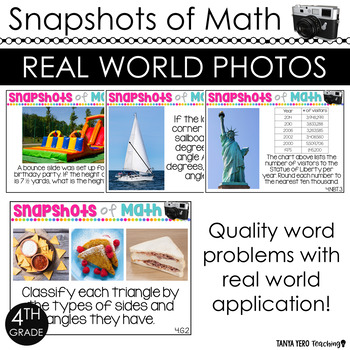4th Grade Word Problems Math Spiral Review
- Zip
What educators are saying
Description
Visual representation is important to students. Get your students excited about math by Using Snapshots of Math Word Problems!
This purchase contains 130 word problems for all the 4th grade math standards. Each word problem is applicable for young learners and includes a photo for visual representation. Each question is on a PowerPoint slide for easy use and can be used during a whole group lesson, to introduce a skill, or extra practice.
Standards & Topics Covered
Number and Operation in Base Ten
➥ 4.NB.1 - Place Value Concepts
➥ 4.NBT.2 - Number Form, Word Form, Expanded Form
➥ 4.NBT.3 - Rounding multi-digit whole numbers
➥ 4.NBT.4 - Adding & Subtracting Whole Numbers
➥ 4.NBT.5 - Multiplying whole numbers
➥ 4.NBT.6 - Dividing whole numbers
Operations & Algebraic Thinking
➥ 4.OA.1 - Interpreting multiplication equations
➥ 4.OA.2 - Multiplying and dividing word problems
➥ 4.OA.3 - Solving multistep word problems, including interpreting remainders
➥ 4.OA.4 - Identifying prime and composite numbers within 100
➥ 4.OA.5 - Identifying rules of patterns
Number and Operation - Fractions
➥ 4.NF.1 - Equivalent fractions
➥ 4.NF.2 - Comparing fractions
➥ 4.NF.3 - Adding and subtracting fractions with like denominators, decomposing fractions, adding and subtracting mixed numbers with like denominators
➥ 4.NF. 4 - Multiplying a fraction by a whole number
➥ 4.NF.5 - Adding and subtracting fractions with denominators of 10 and 100
➥ 4.NF.6 - Decimal notation for fractions with denominators of 10 and 100
➥ 4.NF.7 - Comparing decimals to hundredths
Measurement and Data
➥ 4.MD.1 - Measurement and converting measurement
➥ 4.MD.2 - Solving measurement word problems
➥ 4.MD.3 - Area and perimeter of rectangles
➥ 4.MD.4 - Line plots
➥ 4.MD.5 - Angles within a circle
➥ 4.MD.6 - Measuring angles with a protractor
➥ 4.MD.7 - Additive angle measurement, decomposing angles
Geometry
➥ 4.G.1 - Identifying angles in 2D shapes
➥ 4.G.2 - Classifying 2D figures
➥ 4.G.3 - Symmetry





